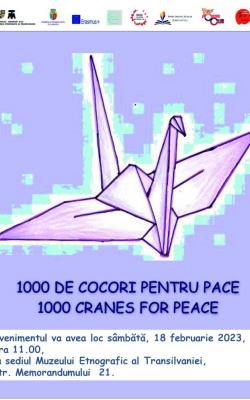The Transylvanian Museum of Ethnography, a public cultural institution that operates under the authority of the Cluj County Council, in partnership with the Para la Inteligencia Social Association, PLIS, from Fuengirola, Spain, the Japanese Cultural Centre and the Sembazuru Japanese Studies Centre within Babeș-Bolyai University, the Direction of Social and Medical Assistance in Cluj-Napoca, Cluj County School Inspectorate, Anime Culture Club, announces the launch of the 1000 Cranes for Peace project.
In Japanese culture, the crane is considered a magical being, a symbol of immortality. According to the ancient traditions of this country, those who manage to make a thousand origami cranes will see their greatest wishes fulfilled. Making a thousand origami cranes (called senbazuru in Japanese) is practiced in Japan, both individually, to fulfill personal wishes, and in smaller or larger groups, to achieve a common desire.
In the middle of the 20th century, the story of the 1000 cranes acquired a world dimension and a special meaning related to the struggle for peace. A 12-year-old girl named Sadako Sasaki became her symbol. Born in Hiroshima, Sadako was only two years old at the time of the nuclear explosion on August 6, 1945. Although she survived the blast, Sadako developed a serious form of leukemia ten years later. Helped by colleagues and friends, she began to make a thousand paper cranes in the hope of recovery. Although Sadako understood that her hopes of recovery were unlikely to come true, she continued to make cranes until near her death, wanting them to spread a message of peace everywhere. “I will write PEACE on your wings and you will fly around the world!” Sadako would have said, and thus the creation of a thousand origami cranes became a symbol of peace throughout the world. The peace message sent by Sadako Sasaki and the thousand cranes made by her and her little friends has been traveling to all the meridians of the globe ever since.
Origami, the Japanese art of paper folding, has definite benefits for developing the physical and intellectual capacities of those who practice it. Origami supports brain development, develops imagination and color sense, improves concentration and spatial awareness. This is why origami is an art form very well represented in the educational system in Japan, and very well-known today throughout the world.
The flight for peace of the 1000 cranes is now being promoted, as part of an Erasmus+ project, by the Transylvanian Museum of Ethnography and the Para la Inteligencia Social Association, PLIS, from Fuengirola, Spain. Our partners are, so far, the Japanese Cultural Centre and the Sembazuru Japanese Studies Centre (both operating within Babeș-Bolyai University), the Direction of Social and Medical Assistance in Cluj-Napoca, the Cluj County School Inspectorate, Anime Culture Club.
Our project begins now, and it will end on February 18, close to the one-year anniversary of the beginning of Europe’s most recent major conflict: Russia’s war against Ukraine. For one month, all organizations, groups, or individuals who wish to participate in this project are expected to contribute to the realization of the 1000 peace cranes.
On February 18, 2023, two exhibitions containing 1000 origami cranes each will be opened, in parallel, in Cluj-Napoca and Fuengirola (Spain), marking the desire for peace of people of all ages in two areas of Europe.











